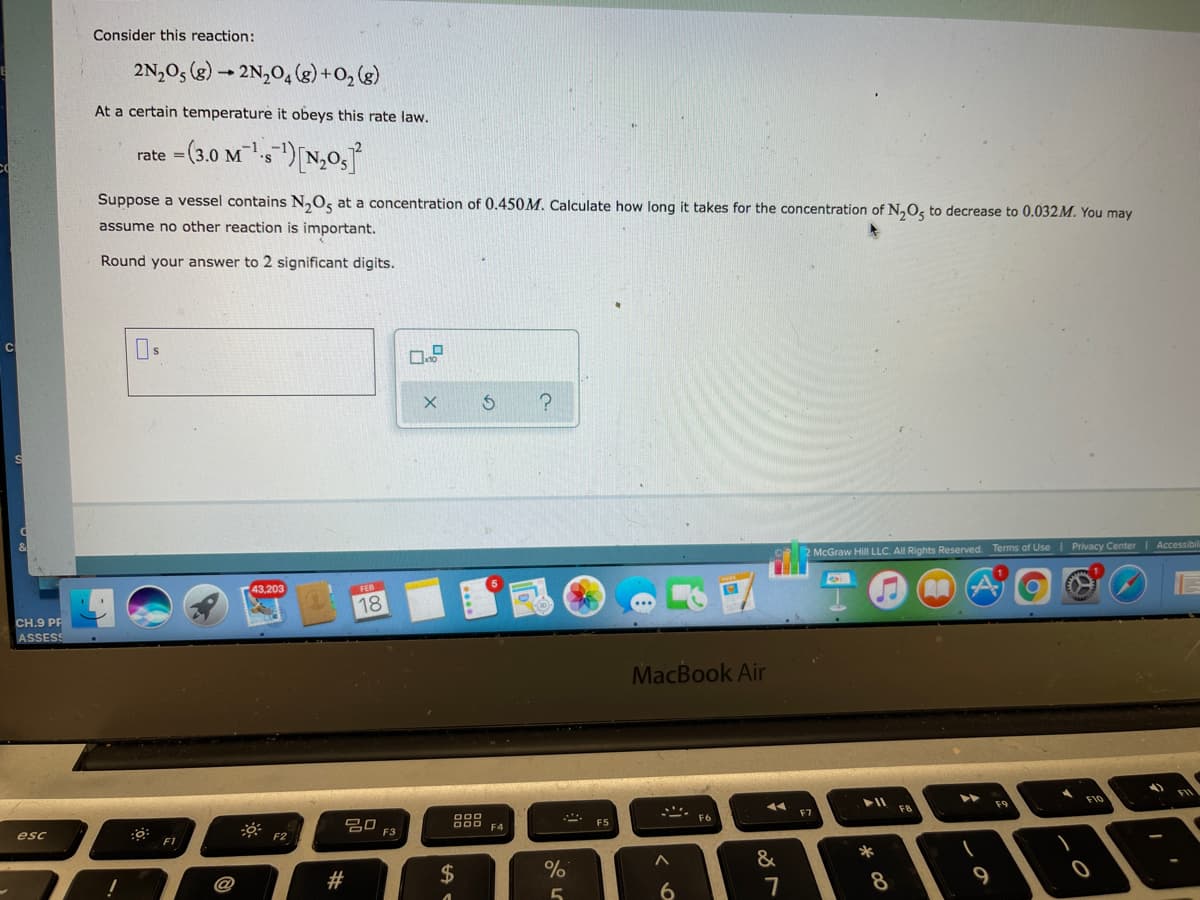2N,0, (g) – 2N,0, (g) +0, (g) At a certain temperature it obeys this rate law. -(3.0 M")[N,0, rate = 'S Suppose a vessel contains N,0, at a concentration of 0.450M. Calculate how long it takes for the concentration of N,O, to decrease to 0.032M. You may assume no other reaction is important. Round your answer to 2 significant digits.
2N,0, (g) – 2N,0, (g) +0, (g) At a certain temperature it obeys this rate law. -(3.0 M")[N,0, rate = 'S Suppose a vessel contains N,0, at a concentration of 0.450M. Calculate how long it takes for the concentration of N,O, to decrease to 0.032M. You may assume no other reaction is important. Round your answer to 2 significant digits.
Chemistry: An Atoms First Approach
2nd Edition
ISBN:9781305079243
Author:Steven S. Zumdahl, Susan A. Zumdahl
Publisher:Steven S. Zumdahl, Susan A. Zumdahl
Chapter11: Chemical Kinetics
Section: Chapter Questions
Problem 5ALQ: Consider the following statements: In general, the rate of a chemical reaction increases a bit at...
Related questions
Question

Transcribed Image Text:Consider this reaction:
2N,05 (g)
- 2N,O, (g) +O, (g)
At a certain temperature it obeys this rate law.
rate = (3.0 M) N,o,
'S
Suppose a vessel contains N,0, at a concentration of 0.450M. Calculate how long it takes for the concentration of N,O, to decrease to 0.032M. You may
assume no other reaction is important.
Round your answer to 2 significant digits.
Co
2 McGraw Hill LLC. All Rights Reserved. Terms of Use
Privacy Center
Accessibil
43,203
FEB
18
CH.9 PP
ASSESS
MacBook Air
F10
esc
吕口
F8
F9
F3
F5
F1
#
24
%
&
*
6
8
Expert Solution
Step 1
2N2O5(g) -----> 2N2O4(g) + O2(g)
Rate = 3.0 M-1 s-1[N2O5]2
Initial concentration of N2O5. = 0.450 M
Final concentration of N2O5. = 0.032 M
Step by step
Solved in 2 steps

Knowledge Booster
Learn more about
Need a deep-dive on the concept behind this application? Look no further. Learn more about this topic, chemistry and related others by exploring similar questions and additional content below.Recommended textbooks for you

Chemistry: An Atoms First Approach
Chemistry
ISBN:
9781305079243
Author:
Steven S. Zumdahl, Susan A. Zumdahl
Publisher:
Cengage Learning

Chemistry: The Molecular Science
Chemistry
ISBN:
9781285199047
Author:
John W. Moore, Conrad L. Stanitski
Publisher:
Cengage Learning

Chemistry: Principles and Reactions
Chemistry
ISBN:
9781305079373
Author:
William L. Masterton, Cecile N. Hurley
Publisher:
Cengage Learning

Chemistry: An Atoms First Approach
Chemistry
ISBN:
9781305079243
Author:
Steven S. Zumdahl, Susan A. Zumdahl
Publisher:
Cengage Learning

Chemistry: The Molecular Science
Chemistry
ISBN:
9781285199047
Author:
John W. Moore, Conrad L. Stanitski
Publisher:
Cengage Learning

Chemistry: Principles and Reactions
Chemistry
ISBN:
9781305079373
Author:
William L. Masterton, Cecile N. Hurley
Publisher:
Cengage Learning

Chemistry: Principles and Practice
Chemistry
ISBN:
9780534420123
Author:
Daniel L. Reger, Scott R. Goode, David W. Ball, Edward Mercer
Publisher:
Cengage Learning

Chemistry for Engineering Students
Chemistry
ISBN:
9781337398909
Author:
Lawrence S. Brown, Tom Holme
Publisher:
Cengage Learning

Chemistry by OpenStax (2015-05-04)
Chemistry
ISBN:
9781938168390
Author:
Klaus Theopold, Richard H Langley, Paul Flowers, William R. Robinson, Mark Blaser
Publisher:
OpenStax